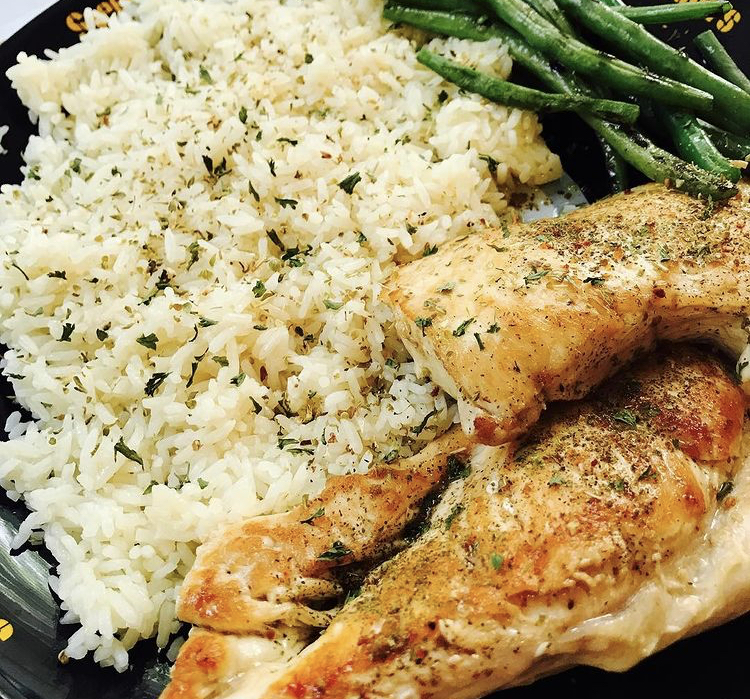
Carbohydrates and sugar sometimes get an unfair shake due to people not understanding the nuances of nutrition. Very few things in nutrition are unequivocally good or bad, healthy or unhealthy.
However, when you discuss nutrition and it’s relation to a certain population, you can make specific recommendations. Anyone reading this already trains hard in the gym, and is looking to optimize their carb intake to build more muscle.
Function of Carbs
Carbohydrates serve multiple purposes for anyone trying to build muscle. While they can’t build muscle on their own like protein, they can aid muscle growth in other ways. In fact, combining protein and carbs in a meal has more of an anabolic effect than protein on its own.
Carbs are the primary fuel source for high volume, resistance training exercise. If you train hard with dumbbells, barbells, machines, bands, or bodyweight, you will predominantly be using carbohydrates for energy during that workout. Simply put, more energy means a better workout and a better workout leads to muscle gains.
Workouts are the lost part of the equation nowadays. People throw out the arbitrary 80% diet, 20% training ratio without understanding the importance of hard training. No matter how perfect your diet is, muscle will not grow without hard training. Muscles need adequate mechanical tension from resistance training to grow. They don’t grow for no reason.
As a result, it’s important to get the most out of each workout. Doesn’t mean you have to carb load like a marathon runner, just enough to fuel and recover from the workout (more on how much to eat later).
Carbohydrates can be stored in the form of glycogen in the muscle and liver. It serves as a fuel reserve for exercise that the body can tap into when needed.
This is what makes carbohydrates such a great fuel source; they are stored directly in the muscle. For example, if you are performing a bicep curl, you may use the stored glycogen in the bicep muscle itself. Due to the localized nature of glycogen in the muscle, it provides this energy very quickly. Thus, you can continue to work out at a high pace.
But this goes beyond just workout performance. When carbs are stored as glycogen in the muscle they hold water as well. Since muscle is predominately water anyway this glycogen storage increases the volume of the muscle cell, leading to a fuller and larger appearance.
Full is a term used in bodybuilding circles quite often. Competitive bodybuilders will sometimes say they looked flat on stage because they did not consume enough carbs prior to a show. Often times they’re physiques look way better the following day after consuming a cheat meal. The carbs and sodium from that meal helped their muscles to “fill out.”
Even if you are not a competitive bodybuilder, this illustration shows the importance of carbohydrates in relation to a person’s physique.
How Much to Eat
How many grams of carbohydrates to eat per day is based on your goal. For maximum muscle growth and recovery you should consume about 2-2.5 grams of carbs per pound of bodyweight. This ensures adequate energy for each workout and that glycogen is at full capacity. For a 180lb individual this would be 360-450g per day.
A 2g/lb clip should be enough to build muscle while also limiting fat gain. Of course this is dependent on dietary fat intake and overall calories as well. But with a reasonable intake, 2g/lb is a nice spot to start. Some fat gain is inevitable, but this isn’t dirty bulk territory. Always remember that these are guidelines, so while it’s important to be patient and experiment properly, don’t feel tied down to the numbers.
A body recomposition is when an individual wants to build muscle and lose fat simultaneously. And while it may seem that you are moving in two different directions, studies have shown that this is indeed possible.
If you want to gain as much muscle as possible, or cut down to a very low body fat percentage, then a body recomposition isn’t for you. At a certain point you have to choose between one or the other for optimal results. But some people just want to tighten up their physique without major changes on the scale.
In this situation, 0.8-1 gram of carbs per pound of bodyweight should suffice. It’s enough to get quality workouts to gain muscle without much, if any, spilling over into fat gain. Timing your carb intake properly ensures you’re still getting the most out of each training session.
Women looking to gain maximum amounts of muscle should aim for about 1.5 grams per pound of bodyweight. The body recomposition numbers work for both men and women.

Nutrient Timing
The majority of your daily carbohydrate intake should be consumed both pre and post workout. You may even choose to consume an intra-workout carbohydrate supplement. Consuming carbs around the time of your workout puts them to good use. This is called nutrient partitioning.
Eating carbs pre workout gives the body a readily available fuel source. Carbs digest rather quickly, so eating a meal about an hour before the workout should provide enough time for glucose to enter the bloodstream by the time you start lifting.
Intra-workout carbs serve the same function as a pre workout meal. This is helpful for particularly long workouts, or for people who don’t like to eat before they train but still want the benefit of carbs for workout performance.
Consuming carbs post workout helps with muscle recovery and refilling glycogen stores that may have been depleted during the workout. After a workout, muscles are sensitive to the nutrients coming in. You can take advantage of this by consuming your largest meal of the day post workout. The nutrients will preferentially go to muscle as opposed to fat storage as a result of this sensitivity. It’s not an excuse to go out and gorge yourself, as there are limits to this phenomenon. But it is an advanced technique to get the most out of your daily calories.
Which Carb Sources to Choose
The main factor when choosing carbohydrates is digestibility. There’s nothing worse than feeling bloated and sluggish going into a training session. Earlier we mentioned how crucial training is so it’s paramount to go into each workout feeling good.
Digestibility varies from person-to-person, but there are certain food choices that work well for the majority of people. Cream of rice is a carbohydrate source that digests easily for most people. It’s also a carbohydrate dense food, which means it contains a lot of carbs for a small serving. This is helpful for people in that 2-2.5 grams per pound range that need to pack in the carbs on a daily basis.
Fruit typically is an easily digestible choice as well. Fruit encompasses many different options, but most fruits work well so long as they are in season and ripe. Bananas, apples, grapes, and mangoes are carbohydrate dense, while berries won’t have as many carbs per serving.
One thing to consider when making a choice for yourself is your sensitivity to changes in blood sugar. You may eat a banana pre-workout and be totally fine. But someone else may feel dizzy and uncomfortable mid workout due to a drop in blood sugar.
If you are sensitive to this sort of thing you have two options. One is to choose a slower digesting carbohydrate like oats. Oats contain fiber which leads to a more sustained release of glucose into the blood, compared to something like white bread which would enter the blood very quickly.
Another option is simply to have a more balanced meal. Having carbs with a fat or protein source would slow the digestion of the meal as a whole. So even if you chose a fast digesting carb like a banana, adding something like peanut butter (a fat source) would slow down the rate of digestion.
The glycemic index is the metric used to measure how quickly a food elevates blood sugar. It’s helpful but also overrated in the sense that it measures food in isolation. Typically we don’t eat foods in isolation, we eat them with other foods as part of a meal.
As mentioned, you can effectively change a high glycemic index carbohydrate by combining it with a fat or protein source. But in the event that you are eating a food by itself, the glycemic index can be a helpful tool when making food choices. The only situation in which it really matters is for a pre-workout meal or snack. The rest of the day you will in all likelihood be consuming full, balanced meals where the individual glycemic index ratings are altered by the combination of foods.
Hopefully the guidelines outlined here quell any fears about carbohydrates and how they relate to working out and building muscle. Context is always important.
Recent Posts
Stretching Before Workouts: Essential Warmup or Performance Killer
“Don’t stretch before workouts, your muscles become too supple” “Stretch before your workouts, warming up is important” It's conflicting advice like this that drives people crazy,...
Best Protein Bar For the Money | Cost Effective, High Quality
Protein bars are no longer a supplement dedicated to diehard gym rats, with awful taste and the consistency of a brick. Men, women, and even teenagers can commonly be seen eating protein bars. The...
